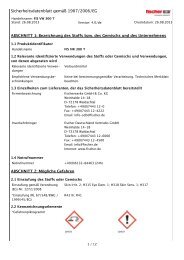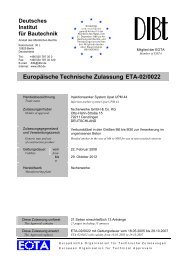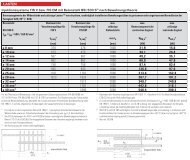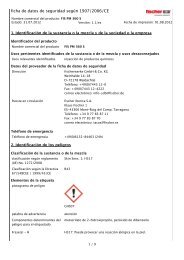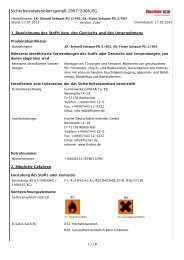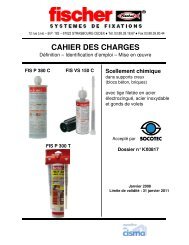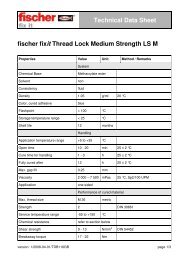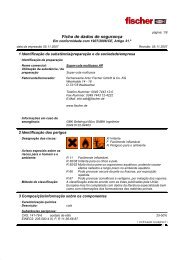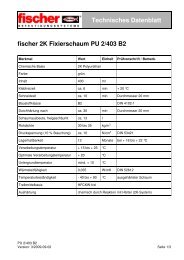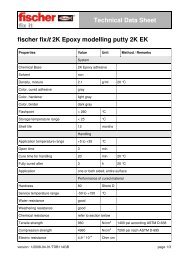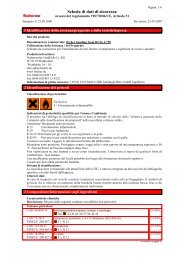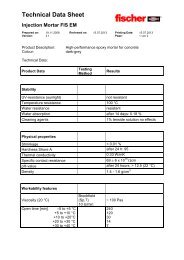fischer Highbond-Anker dynamic FHB dyn Vorsteckmontage ...
fischer Highbond-Anker dynamic FHB dyn Vorsteckmontage ...
fischer Highbond-Anker dynamic FHB dyn Vorsteckmontage ...
Sie wollen auch ein ePaper? Erhöhen Sie die Reichweite Ihrer Titel.
YUMPU macht aus Druck-PDFs automatisch weboptimierte ePaper, die Google liebt.
FIS HB 345 S – Art. No. 33211FIS HB 150 C – Art. No. 77529D Montageanleitung G Installation Instructions E Instrucciones de montaje<strong>fischer</strong> <strong>Highbond</strong>-<strong>Anker</strong> <strong><strong>dyn</strong>amic</strong><strong>FHB</strong> <strong>dyn</strong> Durchsteckmontagebestehend aus: <strong>fischer</strong> <strong>Highbond</strong>-Injektions-Mörtel FIS HB 345 S bzw.FIS HB 150 C <strong>fischer</strong> <strong>Highbond</strong>-<strong>Anker</strong>stange <strong>FHB</strong>-A <strong>dyn</strong>Die <strong>fischer</strong> <strong>Highbond</strong>-<strong>Anker</strong>stange <strong>FHB</strong>-A <strong>dyn</strong> darf nur in Verbindungmit <strong>fischer</strong> Injektions-Mörtel FIS HB 345 S bzw. FIS HB 150 Cverarbeitet werden.<strong>fischer</strong> highbond anchor <strong><strong>dyn</strong>amic</strong><strong>FHB</strong> <strong>dyn</strong> Push-through installationConsisting of: <strong>fischer</strong> highbond injection mortar FIS HB 345 S resp.FIS HB 150 C <strong>fischer</strong> highbond anchor rod <strong>FHB</strong>-A <strong>dyn</strong>The <strong>fischer</strong> highbond anchor rod <strong>FHB</strong>-A <strong>dyn</strong> may only be used inconjunction with <strong>fischer</strong> injection mortar FIS HB 345 S resp.FIS HB 150 C.Anclaje <strong>Highbond</strong> <strong><strong>dyn</strong>amic</strong> <strong>fischer</strong><strong>FHB</strong> <strong>dyn</strong> Montaje a travésCompuesto por: Mortero de inyección <strong>Highbond</strong> <strong>fischer</strong> FIS HB 345 S resp.FIS HB 150 C Varilla de anclaje <strong>Highbond</strong> <strong>fischer</strong> <strong>FHB</strong>-A <strong>dyn</strong>La varilla de anclaje <strong>Highbond</strong> <strong>fischer</strong> <strong>FHB</strong>-A <strong>dyn</strong> sólo puedeutilizarse en combinación con el mortero de inyección <strong>fischer</strong>FIS HB 345 S resp. FIS HB 150 C.(A)(A)(A)dT finstt curedd fffixtdd o1t curedT oinst dT oinst h ef 11. Vormontage, Bohrlocherstellung und Bohrlochreinigung1. Pre-installation, drill and clean hole<strong>Anker</strong>stange gemäß Abbildung (A) oder (B) vormontieren (2 Variantensind möglich).min. 2xmin. 2xmin. 2x(A): Kunststoff-Zentrierhülse, verfüllbare Kegelpfanne, Kugelscheibe, Sechs kantmutterund Sicherungsmutter.(B): Kunststoff-Zentrierhülse, verfüllbare Kugelpfanne, Sechskantmutter mit Kugelkopfund Sicherungsmutter.Bohrlocherstellung: Mit Hammerbohrer zylindrisches Bohrloch durch dasAnbauteil hindurch erstellen. Vorgeschriebenen Bohrlochdurchmesser und Bohrlochtiefegemäß Tabelle 2 einhalten.min. 2xmin. 2xBohrloch gründlich reinigen: Vom Bohrlochgrund mind. 2 x ausblasen, 2 xmin. 2xbürsten und erneut mind. 2 x ausblasen. Erforderliche Bürsten BS, siehe Tabelle 2.Ab Gewindegröße M20 ist das Bohrloch mit ölfreier Druckluft (min. 6 bar) unterVerwendung der Druckluft-Reinigungspistole ABP und der zugehörigen Ausblasdüsemin. 2x(Art.-Nr. 59456) auszublasen.min. 2xmin. 2xUngenügende Reinigung = verminderte Tragfähigkeit.2. Vorbereitung Injektions-Mörtel FIS HB2. Prepare FIS HB injection mortarVerschlusskappe abschrauben. Statikmischer aufschrauben. – Mischspirale imStatikmischer muss deutlich sichtbar sein. Mörtelkartusche in <strong>fischer</strong>2Auspresspistole legen. Mörtel so lange auspressen, bis der austretende Mörtelgleichmäßig grau gefärbt ist. Nicht grau gefärbter Mörtel bindet nichtab und ist zu verwerfen (ca. 2 Pistolenhübe). Niemals ohne Statik-2mischer verwenden.3. Durchsteck-<strong>Anker</strong>montage3. Install push-through anchorDie Bohrlochverfüllung muss durch die Durchgangsbohrung im Anbauteil erfolgen.Injektions-Mörtel FIS HB vom Bohrlochgrund ausgehend hubweise verfüllen (Lufteinschlüssevermeiden). Füllmenge ca. ⅔ des Bohrlochs inkl. Anbauteil (Füllmengesiehe Tabelle 2).<strong>Anker</strong>stange setzen: Vormontierte <strong>Anker</strong>stange unter geringen Drehbewe gungenbis zur Setztiefe eindrücken. Die Setztiefe ist erreicht, wenn die Kunststoff-Zentrierbuchsein die Durchgangsbohrung des Anbauteils eindringt und die Verfüllscheibevollflächig am Anbauteil anliegt. Die Vermörtelung muss bis an die Oberfläche desAnbauteils reichen. Ist dies nicht der Fall, so ist die <strong>Anker</strong>stange sofort zu ziehen underneut Injektionsmörtel zu injizieren.Injektionsmörtel aushärten lassen:Aushärtezeiten des Injektionsmörtels t cure siehe Tabelle 1.Sechskantmutter mit Montagedrehmoment T inst (siehe Tabelle 2) festziehen.Sicherungs mutter handfest anziehen und mit Schraubenschlüssel ¼ bis ½ Umdrehungfestziehen.3Bei der Ausführung hochkorrosionsbeständiger Edelstahl ist die Sicherungsmuttereine Flachmutter. Diese ist mit einem Drehmoment von ¼ T inst festzuziehen.3Tabelle 1: Verarbeitungs- und AushärtezeitTable 1: Processing and setting timeKartuschentemperatur*Offenzeit/Temperatur im Aushärtezeit**Temperature Open time/Temperature in Setting time**Verarbeitungszeit Verankerungsgrundof cartridge* setting timethe keying surface°CMin.°CMin.°CMin.°CMin.– 5 bis ± 0 360– 5 to ± 0 360+ 1 bis + 5 180+ 1 to + 5 180+ 5 15 + 6 bis + 10 90+ 5 15 + 6 to + 10 90+ 20 6 + 11 bis + 20 35+ 20 6 + 11 to + 20 35+ 30 4 + 21 bis + 30 20+ 30 4 + 21 to + 30 20+ 40 2 + 31 bis + 40 12+ 40 2 + 31 to + 40 12* Kartuschentemperatur darf + 5 °C nicht unterschreiten.* The temperature of the cartridge must not fall below + 5 °C.** Im feuchten Verankerungsgrund sind die Wartezeiten zu verdoppeln.** For damp surfaces, waiting times must be doubled.T insth o ttdTabelle 2 / Table 2 / Tabla 2hh efefh o t fixh o tdt fixt cureZ–21.3–1748<strong>Highbond</strong>-<strong>Anker</strong><strong>FHB</strong>-A <strong>dyn</strong>h ef[mm]t fix[mm]t d[mm]Pre-install anchor rod as shown in Figures (A) or (B) (2 possible variants).(A): Plastic centring sleeve, fillable conical seat, spherical washer, hexagonal nutand counter nut.(B): Plastic centring sleeve, fillable conical seat, hexagonal nut with ball head andcounter nut.Drill hole: Drill a cylindrical hole through the attached component using a hammerdrill. Ensure that the drill hole diameter and depth comply with the values specifiedin Table 2.Clean the drill hole thoroughly: Starting from the bottom, blow the drill holeclear at least twice, brush it twice, then blow it clear two more times. For requiredbrushes (BS), see Table 2. For thread sizes M20 and higher, the hole must be blownclear with oil-free pressurised air (at least 6 bar), using an ABP pressurised aircleaning gun and the appropriate blow-out nozzle (item no. 59456).Insufficient cleaning = reduced bearing capacity.Unscrew the cap. Attach the static mixer. – The spiral mixer in the staticmixer must be clearly visible. Insert the mortar cartridge into the <strong>fischer</strong> applicationgun. Squeeze out mortar until it is an even grey colour when it leaves the gun.Mortar that is not grey does not set and must be discarded (approx.2 gun strokes). Never use without the static mixer.The drill hole must be filled through the through-hole in the attached component.Fill in the drill hole with FIS HB injection mortar starting from the bottom, one shotat a time (avoid air pockets). Fill quantity approx. ⅔ of the drill hole incl. attachedcomponent (for fill quantity, see Table 2).Set anchor rod: Press in the pre-installed anchor rod, turning it slightly, until itreaches the setting depth. The setting depth is reached when the plastic centringbush penetrates the through bore of the attached component and the filling washerrests on this component with its full surface. Mortaring must reach up to the surfaceof the attached component. If this is not the case, the anchor rod must be immediatelyremoved and injection mortar must be injected in the drill hole again.Allow injection mortar to harden:For the hardening times of t cure injection mortar, see Table 1.Tighten the hexagonal nut with installation torque T inst (see Table 2). Tighten counternut manually, then use a wrench to give it another quarter or half turn.In the highly corrosion-resistant stainless steel version, the counter nut is a thin nut.Tighten this with a torque of ¼ T inst .d o[mm]h o[mm]TT instinst1. Montaje previo, taladrado y limpieza del agujeroRealice el montaje previo de la varilla de anclaje según la figura(A) o (B) (son posibles 2 variantes).(A): Vaina de centrado de plástico, arandela cónica rellenable, arandela cóncava,tuerca hexagonal y tuerca de seguridad.(B): Vaina de centrado de plástico, cazoleta rellenable, tuerca hexagonal con cabezaesférica y tuerca de seguridad.Taladrado del agujero: Con un taladro de percusión haga un agujero cilíndricoa través de la pieza de montaje. Observe el diámetro y la profundidad de taladradoque se reflejan en la tabla 2.Limpiar a fondo el agujero taladrado: Desde el fondo del agujero taladrado haciafuera, realice los siguientes trabajos: aplicar 2 veces aire con un fuelle como mínimo, aplicar2 veces como mínimo un cepillo para sacar los restos y aplicar de nuevo 2 veces aire con unfuelle como mínimo. Cepillos adecuados BS, véase tabla 2. A partir del tamaño de rosca M20se debe aplicar al agujero aire comprimido sin aceite (mín. 6 bar) con ayuda de la pistola delimpieza de aire comprimido ABP y de la boquilla de soplado correspondiente (n° art. 59456).Limpieza insuficiente = Capacidad de carga reducida.2. Preparación de la argamasa de inyección FIS HBDesenrosque la tapa de cierre. Abra la boquilla mezcladora. – La espiral demezcla de la boquilla mezcladora debe poder verse claramente. Coloqueel cartucho de argamasa en la pistola de inyección de <strong>fischer</strong>. Extraiga argamasa hastaque ésta presente un color gris homogéneo. La argamasa que no presenteuna coloración gris no sirve y se debe desechar (aprox. 2 aplicacionesde pistola). Nunca se debe utilizar sin boquilla mezcladora.3. Montaje del ancla a travésEl relleno del agujero taladrado se debe realizar a través del agujero pasante. Relleneargamasa FIS HB desde el fondo del agujero hacia fuera aplicando varias veces conla pistola (evite la entrada de aire). Cantidad de llenado aprox. ⅔ del agujero taladradoincl. pieza de montaje (cantidad de llenado, véase tabla 2).Colocar la varilla de anclaje: Presione la varilla de anclaje premontada aplicandoleves movimientos de giro hasta alcanzar la profundidad de inserción. Laprofundidad de inserción se alcanza cuando el casquillo de centrado de plásticopenetra en el agujero pasante de la pieza de montaje y la arandela de relleno entraen contacto en toda su superficie con la pieza de montaje. La cantidad de argamasadebe llegar hasta la superficie de la pieza de montaje. De no ser éste el caso, saqueinmediatamente la varilla de anclaje e inyecte de nuevo argamasa de inyección.Dejar que la argamasa de inyección se endurezca:Tiempos de endurecimiento de la argamasa de inyección t cure , véase tabla 1.Apriete la tuerca hexagonal con el par de montaje Tinst (véase tabla 2). Apriete amano la tuerca de seguridad y gírela con una llave para tornillos ¼ a ½ vuelta.En el modelo de acero inoxidable altamente resistente a la corrosión, la tuerca deseguridad es una tuerca plana. Ésta se debe apretar con un par de ¼ T inst .Tabla 1: Tiempo de trabajabilidad y endurecimientoTemperaturade los cartuchos*°CTiempo detrabajabilidadMin.(B)(B)(B)Temperatura enla base de anclaje°CTiempo deendurecimiento**Min.– 5 – ± 0 360+ 1 – + 5 180+ 5 15 + 6 – + 10 90+ 20 6 + 11 – + 20 35+ 30 4 + 21 – + 30 20+ 40 2 + 31 – + 40 12* La temperatura de los cartuchos nunca debe ser inferior a + 5 °C.** En el caso de bases de anclaje húmedas, se deberán duplicar los tiempos de espera.12 x 100/25 100 8–25 130 14 130 – t fix 15 40 7 19 BS 1412 x 100/50 100 8–50 155 14 155 – t fix 15 40 8 19 BS 1416 x 125/25 125 10–25 155 18 155 – t fix 19 60 9 24 BS 16/1816 x 125/50 125 10–50 155 18 180 – t fix 19 60 10 24 BS 16/1820 x 170/50 170 12–50 225 24 225 – t fix 25 100 23 30 BS 2424 x 220/50 220 14–50 225 28 275 – t fix 29 120 38 36 BS 28d f[mm]T inst[Nm]119780 · 27/2011<strong>fischer</strong>werke GmbH & Co. KGWeinhalde 14–18 · 72178 Waldachtal · GermanyTel. +49 (0) 7443 12-0 · Fax +49 (0) 7443 12-4222www.<strong>fischer</strong>.de<strong>fischer</strong> fixing (UK) LtdWhitely Road · Wallingford, Oxfordshire · OX10 9AT – United KingdomPhone +44 1491 827900 · Fax +44 1491 827953www.<strong>fischer</strong>.co.uk<strong>fischer</strong> Ibérica, S.A.C/ Klaus Fischer, 1 · 43300 Mont-roig del Camp / Tarragona · SpainTel. +34 977 8387-11 · Fax +34 977 8387-70www.<strong>fischer</strong>.es



